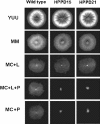Fungal metabolic model for tyrosinemia type 3: molecular characterization of a gene encoding a 4-hydroxy-phenyl pyruvate dioxygenase from Aspergillus nidulans
- PMID: 16896227
- PMCID: PMC1539140
- DOI: 10.1128/EC.00160-06
Fungal metabolic model for tyrosinemia type 3: molecular characterization of a gene encoding a 4-hydroxy-phenyl pyruvate dioxygenase from Aspergillus nidulans
Abstract
Mutations in the human HPD gene (encoding 4-hydroxyphenylpyruvic acid dioxygenase) cause hereditary tyrosinemia type 3 (HT3). We deleted the Aspergillus nidulans homologue (hpdA). We showed that the mutant strain is not able to grow in the presence of phenylalanine and that it accumulates increased concentrations of tyrosine and 4-hydroxyphenylpyruvic acid, mimicking the human HT3 phenotype.
Figures



Similar articles
-
Mutations in the 4-hydroxyphenylpyruvic acid dioxygenase gene are responsible for tyrosinemia type III and hawkinsinuria.Mol Genet Metab. 2000 Nov;71(3):506-10. doi: 10.1006/mgme.2000.3085. Mol Genet Metab. 2000. PMID: 11073718
-
Animal models reveal pathophysiologies of tyrosinemias.J Nutr. 2003 Jun;133(6 Suppl 1):2063S-2067S. doi: 10.1093/jn/133.6.2063S. J Nutr. 2003. PMID: 12771366 Review.
-
The genetic tyrosinemias.Am J Med Genet C Semin Med Genet. 2006 May 15;142C(2):121-6. doi: 10.1002/ajmg.c.30092. Am J Med Genet C Semin Med Genet. 2006. PMID: 16602095 Review.
-
A nonsense mutation in the 4-hydroxyphenylpyruvic acid dioxygenase gene (Hpd) causes skipping of the constitutive exon and hypertyrosinemia in mouse strain III.Genomics. 1995 Jan 1;25(1):164-9. doi: 10.1016/0888-7543(95)80122-3. Genomics. 1995. PMID: 7774914
-
Manifestation of hawkinsinuria in a patient compound heterozygous for hawkinsinuria and tyrosinemia III.Mol Genet Metab. 2007 Aug;91(4):379-83. doi: 10.1016/j.ymgme.2007.04.008. Epub 2007 Jun 7. Mol Genet Metab. 2007. PMID: 17560158
Cited by
-
Intracellular growth is dependent on tyrosine catabolism in the dimorphic fungal pathogen Penicillium marneffei.PLoS Pathog. 2015 Mar 26;11(3):e1004790. doi: 10.1371/journal.ppat.1004790. eCollection 2015 Mar. PLoS Pathog. 2015. PMID: 25812137 Free PMC article.
-
Transcriptome analysis of Stagonospora nodorum: gene models, effectors, metabolism and pantothenate dispensability.Mol Plant Pathol. 2012 Aug;13(6):531-45. doi: 10.1111/j.1364-3703.2011.00770.x. Epub 2011 Dec 6. Mol Plant Pathol. 2012. PMID: 22145589 Free PMC article.
-
Metabolic Pathway Profiling in Intracellular and Extracellular Environments of Streptococcus thermophilus During pH-Controlled Batch Fermentations.Front Microbiol. 2020 Jan 21;10:3144. doi: 10.3389/fmicb.2019.03144. eCollection 2019. Front Microbiol. 2020. PMID: 32038577 Free PMC article.
-
Molecular Targets of Herbicides and Fungicides─Are There Useful Overlaps for Fungicide Discovery?J Agric Food Chem. 2023 Dec 27;71(51):20532-20548. doi: 10.1021/acs.jafc.3c07166. Epub 2023 Dec 15. J Agric Food Chem. 2023. PMID: 38100716 Free PMC article. Review.
-
Transcriptome and Quasi-Targeted Metabolome Analyze Overexpression of 4-Hydroxyphenylpyruvate Dioxygenase Alleviates Fungal Toxicity of 9-Phenanthrol in Magnaporthe oryzae.Int J Mol Sci. 2022 Jun 27;23(13):7116. doi: 10.3390/ijms23137116. Int J Mol Sci. 2022. PMID: 35806121 Free PMC article.
References
-
- Endo, F., Y. Tanaka, K. Tomoeda, A. Tanoue, G. Tsujimoto, and K. Nakamura. 2003. Animal models reveal pathophysiologies of tyrosinemias. J. Nutr. 133:2063S-2067S. - PubMed
-
- Endo, F., A. Kitano, I. Uehara, N. Nagata, I. Matsuda, T. Shinka, T. Kuhara, and I. Matsumoto. 1983. Four-hydroxyphenylpyruvic acid oxidase deficiency with normal fumarylacetoacetate: a new variant form of hereditary hypertyrosinemia. Pediatr. Res. 17:92-96. - PubMed
-
- Fernández-Cañón, J. M., and M. A. Peñalva. 1995. Molecular characterization of a gene encoding a homogentisate dioxygenase from Aspergillus nidulans and identification of its human and plant homologues. J. Biol. Chem. 270:21199-21205. - PubMed
Publication types
MeSH terms
Substances
LinkOut - more resources
Full Text Sources
Molecular Biology Databases

